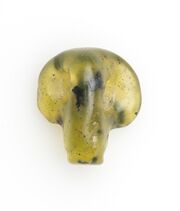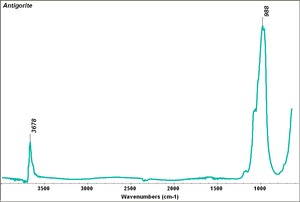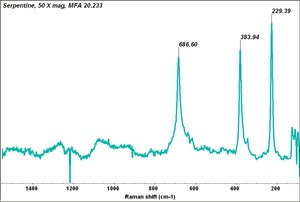Serpentine
Description
An ornamental green mineral composed of hydrated magnesium silicate. Serpentine can range in color from yellow, green, gray, brown, or black and often contains crystals of green olivine and black veins or patches. Serpentine has been gathered or mined since Paleolithic times. Serpentine is mined in Egypt, England (Cornwall), China, Canada (Quebec), Italy, Norway, Russia, South Africa, and the United States (Deer Isle, California). It is used as a building stone and as a source of Asbestos.
Varieties include:
- Antigorite is a soft, coarse-grain form that has a dull, waxy color. Antigorite was used in Egypt in the Pharaonic period for small vessels, amulets, and scarabs.
- Chrysotile, is harder with a silky, fibrous structure. Chrysotile, found in Cyprus and Afghanistan, was used for beads, amulets, seals, and inlays and was often misnamed as Jade (Ogden 1982).
- Lizardite, can be a mottlish yellow with dark gray or black patches.
- Bowenite, was a favorite of Chinese carvers. It is harder than the other varieties and has been used a a substitute for jade
Synonyms and Related Terms
serpentina (Esp., Port.); serpentine (Fr.); Serpentin (Deut.); serpentijn (Ned.); antigorite; chrysotile; black jasper; Genoa green; Alpine green; Tinos green; verde antique; green marble; marmolite; picrolite; asbestos; Deer Isle; bowenite; lizardite
Risks
- Noncombustible.
- The fibers from chrysotile (asbestos) are highly toxic by inhalation.
Physical and Chemical Properties
- Monoclinic, crystals rare, usually massive (antigorite) or fibrous (chrysotile)
- Cleavage = almost perfect
- Fracture = conchoidal (antigorite) or uneven (chrysotile)
- Luster = vitreous, silky, greasy
- Streak = white, greenish-white
- Low birefringence
- May be translucent to opaque
- Translucent stones may show black inclusions, white veining, or moss-like shapes
| Composition | Mg3Si2O5(OH)4 |
|---|---|
| Mohs Hardness | 3.5-4.0 (antigorite), 2.5-3.0 (chrysolite); 2.5 (lizardite) |
| Density | 2.2-2.65 g/ml |
| Refractive index | 1.56-1.57 |
Resources and Citations
- Jack Odgen, Jewellery of the Ancient World, Rizzoli International Publications Inc., New York City, 1982
- Gem Identification Lab Manual, Gemological Institute of America, 2016.
- Luciana and Tiziano Mannoni, Marble: the history of a culture, Facts on File Publications
- C.W.Chesterman, K.E.Lowe, Audubon Society Field Guide to North American Rocks and Minerals, Alfred A. Knopf, New York, 1979
- R.F.Symmes, T.T.Harding, Paul Taylor, Rocks, Fossils and Gems, DK Publishing, Inc., New York City, 1997
- A.Lucas, J.R.Harris, Ancient Egyptian Materials and Industries, Edward Arnold Publishers Ltd., London, 4th edition, 1962
- Wikipedia: [https://en.wikipedia.org/wiki/Serpentine_subgroup Serpentine subgroup (Accessed Nov. 9, 2005 and Dec 2022)
- G.S.Brady, Materials Handbook, McGraw-Hill Book Co., New York, 1971 Comment: p. 702
- Ralph Mayer, A Dictionary of Art Terms and Techniques, Harper and Row Publishers, New York, 1969 (also 1945 printing)
- Richard S. Lewis, Hawley's Condensed Chemical Dictionary, Van Nostrand Reinhold, New York, 10th ed., 1993
- George Savage, Art and Antique Restorer's Handbook, Rockliff Publishing Corp, London, 1954
- Dictionary of Building Preservation, Ward Bucher, ed., John Wiley & Sons, Inc., New York City, 1996
- CRC Handbook of Chemistry and Physics, Robert Weast (ed.), CRC Press, Boca Raton, Florida, v. 61, 1980 Comment: density=2.50-5.65
- Michael McCann, Artist Beware, Watson-Guptill Publications, New York City, 1979
- Random House, Webster's Encyclopedic Unabridged Dictionary of the English Language, Grammercy Book, New York, 1997
- The American Heritage Dictionary or Encarta, via Microsoft Bookshelf 98, Microsoft Corp., 1998




